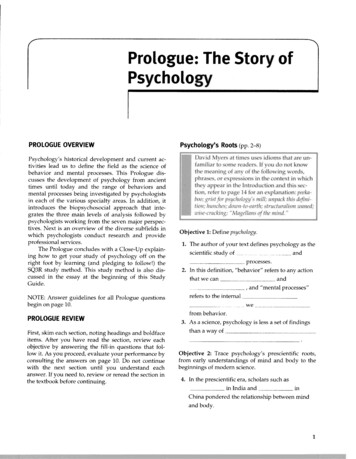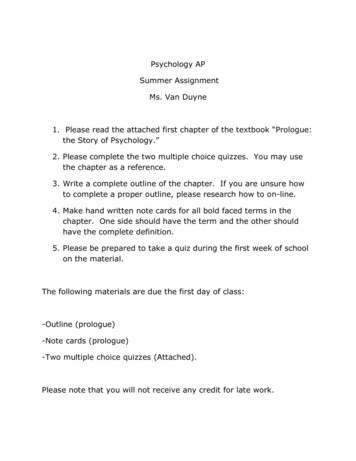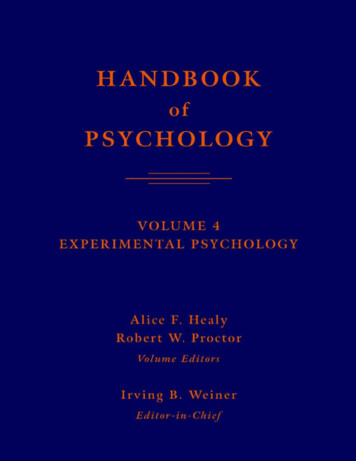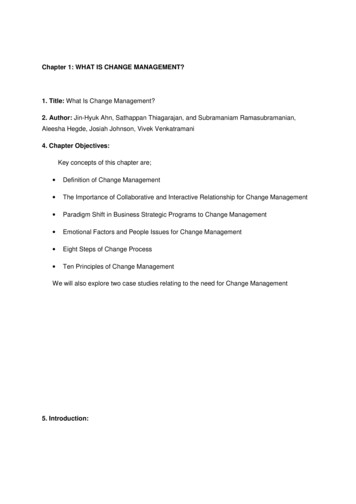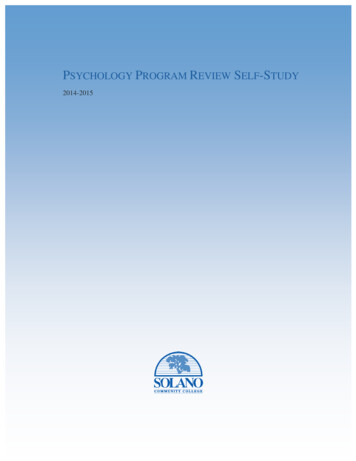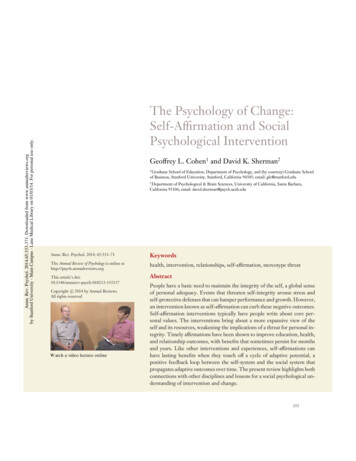
Transcription
PS65CH13-CohenARIANNUALREVIEWS31 October 201313:5FurtherAnnu. Rev. Psychol. 2014.65:333-371. Downloaded from www.annualreviews.orgby Stanford University - Main Campus - Lane Medical Library on 01/03/14. For personal use only.Click here for quick links toAnnual Reviews content online,including: Other articles in this volume Top cited articles Top downloaded articles Our comprehensive searchThe Psychology of Change:Self-Affirmation and SocialPsychological InterventionGeoffrey L. Cohen1 and David K. Sherman21Graduate School of Education, Department of Psychology, and (by courtesy) Graduate Schoolof Business, Stanford University, Stanford, California 94305; email: glc@stanford.edu2Department of Psychological & Brain Sciences, University of California, Santa Barbara,California 93106; email: david.sherman@psych.ucsb.eduAnnu. Rev. Psychol. 2014. 65:333–71KeywordsThe Annual Review of Psychology is online athttp://psych.annualreviews.orghealth, intervention, relationships, self-affirmation, stereotype threatThis article’s doi:10.1146/annurev-psych-010213-115137Abstractc 2014 by Annual Reviews.Copyright All rights reservedWatch a video lecture onlinePeople have a basic need to maintain the integrity of the self, a global senseof personal adequacy. Events that threaten self-integrity arouse stress andself-protective defenses that can hamper performance and growth. However,an intervention known as self-affirmation can curb these negative outcomes.Self-affirmation interventions typically have people write about core personal values. The interventions bring about a more expansive view of theself and its resources, weakening the implications of a threat for personal integrity. Timely affirmations have been shown to improve education, health,and relationship outcomes, with benefits that sometimes persist for monthsand years. Like other interventions and experiences, self-affirmations canhave lasting benefits when they touch off a cycle of adaptive potential, apositive feedback loop between the self-system and the social system thatpropagates adaptive outcomes over time. The present review highlights bothconnections with other disciplines and lessons for a social psychological understanding of intervention and change.333
PS65CH13-CohenARI31 October 201313:5ContentsAnnu. Rev. Psychol. 2014.65:333-371. Downloaded from www.annualreviews.orgby Stanford University - Main Campus - Lane Medical Library on 01/03/14. For personal use only.INTRODUCTION . . . . . . . . . . . . . . . . . . . . . . . . . . . . . . . . . . . . . . . . . . . . . . . . . . . . . . . . . . . . . . .The Pervasive Psychology of Self-Defense . . . . . . . . . . . . . . . . . . . . . . . . . . . . . . . . . . . . . . .Self-Affirmation Theory . . . . . . . . . . . . . . . . . . . . . . . . . . . . . . . . . . . . . . . . . . . . . . . . . . . . . . . .What Are Self-Affirmations? . . . . . . . . . . . . . . . . . . . . . . . . . . . . . . . . . . . . . . . . . . . . . . . . . . . .Understanding the Effects of Self-Affirmation . . . . . . . . . . . . . . . . . . . . . . . . . . . . . . . . . . . .Cycles of Adaptive Potential: How Social Psychological Processes Suchas Self-Affirmation Propagate Through Time . . . . . . . . . . . . . . . . . . . . . . . . . . . . . . . . .AFFIRMATION INTERVENTIONS . . . . . . . . . . . . . . . . . . . . . . . . . . . . . . . . . . . . . . . . . . . . .Education . . . . . . . . . . . . . . . . . . . . . . . . . . . . . . . . . . . . . . . . . . . . . . . . . . . . . . . . . . . . . . . . . . . . . .Health . . . . . . . . . . . . . . . . . . . . . . . . . . . . . . . . . . . . . . . . . . . . . . . . . . . . . . . . . . . . . . . . . . . . . . . . .Intergroup Conflict and Interpersonal Relationships . . . . . . . . . . . . . . . . . . . . . . . . . . . . . .IMPLICATIONS, QUALIFICATIONS, AND QUESTIONS . . . . . . . . . . . . . . . . . . . . .Lessons . . . . . . . . . . . . . . . . . . . . . . . . . . . . . . . . . . . . . . . . . . . . . . . . . . . . . . . . . . . . . . . . . . . . . . . .Moderators and Boundary Conditions . . . . . . . . . . . . . . . . . . . . . . . . . . . . . . . . . . . . . . . . . . .Connections With Other Research Areas . . . . . . . . . . . . . . . . . . . . . . . . . . . . . . . . . . . . . . . .CONCLUSION . . . . . . . . . . . . . . . . . . . . . . . . . . . . . . . . . . . . . . . . . . . . . . . . . . . . . . . . . . . . . . . . . ODUCTIONSelf-integrity: theperception of oneselfas morally andadaptively adequate334In the 1940s, despite war shortages in finer meats and produce, many American homemakersrefused to purchase inferior but more abundant foods even when pressured with patriotic appeals.But when Kurt Lewin (1997/1948) brought homemakers together in small groups to talk aboutobstacles to serving the recommended foods—thus creating a new group norm around the desiredbehavior—their purchase patterns changed. In the U.S. Civil Rights era, prejudice was widespread,and opposition to equal rights proved tenacious in many quarters. But when Milton Rokeach (1973)threatened Americans’ conception of themselves as compassionate—with a brief insinuation thatthey valued their own freedom more than the freedom of others—their support for civil rightsstrengthened in a lasting way.Today many social problems afflict society—inequalities in education, health, and economicoutcomes; political polarization; and intergroup conflict. But these social problems share a psychological commonality with the historical cases described above. The commonality is the notionthat barriers and catalysts to change can be identified and that social psychological interventionscan bring about long-term improvement.This review has two purposes. First it looks at threats to, and affirmations of, the self as barriersand catalysts to change. Threats and affirmations arise from the self ’s fundamental motive: to bemorally and adaptively adequate, good and efficacious. How people maintain the integrity of theself, especially when it comes under threat, forms the focus of self-affirmation theory (Steele 1988;see also Aronson et al. 1999, Sherman & Cohen 2006). We provide an overview of self-affirmationtheory and review research in three areas where the theory has yielded impactful self-affirmationinterventions: education, health, and interpersonal and intergroup relationships.A second purpose of this review is to address questions related to the psychology of changeraised by self-affirmation research. Increasingly, social psychological research demonstrates thepotential for brief interventions to have lasting benefits (Cohen & Garcia 2008, Garcia & Cohen,2012, Walton & Cohen 2011, Wilson 2011, Yeager & Walton 2011). These interventions helppeople to adapt to long-term challenges. For example, a series of 10-minute self-affirmingCohen·Sherman
PS65CH13-CohenARI31 October 201313:5Annu. Rev. Psychol. 2014.65:333-371. Downloaded from www.annualreviews.orgby Stanford University - Main Campus - Lane Medical Library on 01/03/14. For personal use only.exercises, which prompt people to write about core personal values, raised minority studentachievement in public schools, with effects that persisted for years (Cohen et al. 2006, 2009;Sherman et al. 2013). How is this possible? How and when do social psychological interventionssuch as self-affirmation spark lasting positive change? An impactful intervention acts like almostany formative experience. It works not in isolation but rather like a turning point in a story, anevent that sets in motion accumulating consequences (Elder 1998). Timely interventions canchannel people into what we refer to as a cycle of adaptive potential. This is a series ofreciprocally reinforcing interactions between the self-system and a social system, such as a school,that propagates adaptive outcomes over time (cf. Elder 1974, Wilson 2011). The self acts; thesocial system reacts; and the cycle repeats in a feedback loop (Caspi & Moffitt 1995). We discusslessons for intervention and for a social psychological understanding of change.The Pervasive Psychology of Self-DefenseCycle of adaptivepotential: a positivefeedback loop betweenthe self-system and thesocial system thatpropagates adaptiveoutcomes over timePsychological threat:the perception ofenvironmentalchallenge to one’sself-integrityKey to understanding the effects of affirmation is psychological threat, the perception of an environmental challenge to the adequacy of the self. Whether people see their environment asthreatening or safe marks a dichotomy that runs through research not only on self-affirmation butalso on attachment, stress, and coping (see Worthman et al. 2010). Psychological threat representsan inner alarm that arouses vigilance and the motive to reaffirm the self (Steele 1988). Althoughpsychological threat can sometimes trigger positive change (Rokeach 1973, Stone et al. 1994), itcan also impede adaptive coping. People may focus on the short-term goal of self-defense, oftenat the cost of long-term learning. Like a distracting alarm, psychological threat can also consumemental resources that could otherwise be marshaled for better performance and problem solving.Thus, psychological threat can raise a barrier to adaptive change.Major life events, such as losing one’s job or receiving a medical diagnosis, can obviously giverise to psychological threat. But the self-integrity motive is so strong that mundane events canthreaten the self as well and instigate defensive responses to protect it (Sherman & Cohen 2006).When people make trivial choices, such as between two similarly appealing music albums, they tendto defensively rationalize their selection (Steele et al. 1993). When partisans encounter evidencethat challenges their political views, they tend to reflexively refute it (Cohen et al. 2007). Whensports fans see their favorite team suffer a defeat, they experience it partly as their own and increasetheir consumption of unhealthy comfort foods (Cornil & Chandon 2013; see also Sherman & Kim2005). When people confront petty insults, they sometimes turn to violence and even homicide toreassert an image of personal strength and honor in the minds of others (Cohen et al. 1996; see alsoBaumeister et al. 1996). Although the objective stakes of many of these situations seem low, thesubjective stakes for the self can be high. That everyday events can bring about feelings of threatand trigger extreme responses attests to the power and pervasiveness of the self-integrity motive.Greenwald (1980) likened the self to a totalitarian regime that suppresses and distorts information to project an image of itself as good, powerful, and stable. However, unlike a totalitarianregime, people can be self-critical. They sometimes denigrate themselves more than outside observers do and believe that others judge them more harshly than they actually do (e.g., Savitskyet al. 2001). People can feel guilty for events they have little control over (Doosje et al. 2006). Although they can spin idealized fantasies of their abilities, they can also give accurate self-appraisalsat moments of truth (Armor & Sackett 2006). Storyteller rather than totalitarian regime seemsan apt metaphor for the self. The self has a powerful need to see itself as having integrity, butit must do so within the constraints of reality (Adler 2012, Kunda 1990, Pennebaker & Chung2011, Wilson 2011). The goal is not to appraise every threat in a self-flattering way but rather tomaintain an overarching narrative of the self ’s adequacy. A healthy narrative gives people enoughwww.annualreviews.org Self-Affirmation and Social Psychological Intervention335
ARI31 October 201313:5optimism to “stay in the game” in the face of the daily onslaught of threats, slights, challenges,aggravations, and setbacks.Successful social psychological interventions help individuals access this narrative processthrough two avenues (see also Wilson 2011). One avenue is to encourage people to appraisea difficult circumstance in a hopeful and nondefensive way that, in turn, sustains the perceivedadequacy of the self. Helping trauma victims make sense of their experiences promotes health(Pennebaker & Chung 2011); helping students to interpret mistakes as an opportunity forgrowth rather than evidence of incompetence improves their academic performance (Dweck 2008,Walton & Cohen 2011, Wilson & Linville 1982, Yeager et al. 2014); and helping parents to seetheir infants’ cries in a more sympathetic and less defensive light reduces abuse (Bugental et al.2002). A second avenue for intervention focuses on changing not people’s appraisal of a specificchallenge but their appraisal of themselves. The present review addresses this second avenue andthe theory that it proceeds from, self-affirmation theory.Annu. Rev. Psychol. 2014.65:333-371. Downloaded from www.annualreviews.orgby Stanford University - Main Campus - Lane Medical Library on 01/03/14. For personal use only.PS65CH13-CohenSelf-Affirmation TheoryThe postulate that people are motivated to maintain self-integrity rests at the center of selfaffirmation theory (Steele 1988; see also Sherman & Cohen 2006). Self-integrity is a sense ofglobal efficacy, an image of oneself as able to control important adaptive and moral outcomes inone’s life. Threats to this image evoke psychological threat (see Steele 1988, Sherman & Cohen2006). Three points about this motive merit emphasis.First, the motive is to maintain a global narrative of oneself as a moral and adaptive actor (“I ama good person”), not a specific self-concept (e.g., “I am a good student”) (cf. Aronson 1969). Withtime, people may commit themselves to a particular self-definition (e.g., parent, teacher). However,the self can draw on a variety of roles and identities to maintain its perceived integrity. Suchflexibility can be adaptive. People can flexibly define success in a way that puts their idiosyncraticstrengths in a positive light, establishing a reliable but realistic basis for self-integrity (Dunning2005). The flexibility of the self-system can also promote adaptation, especially in dynamic socialsystems. Lower animals have relatively simple goals that they try to meet. A mouse unable toforage for food would be a failure. But humans have a unique ability to adapt to a vast range ofcircumstances. For children and adults, the flexibility of the self-system may foster adaptation tothe wide array of challenges they face across cultures and over the lifespan (Worthman et al. 2010).Second, the motive for self-integrity is not to be superior or excellent, but to be “good enough,”as the term “adequate” implies—to be competent enough in a constellation of domains to feel thatone is a good person, moral and adaptive. An implication for intervention is that, to affirm theself, an event need foster only a sense of adequacy in a personally valued domain, not a perceptionof overall excellence.Third, the motive for self-integrity is not to esteem or praise oneself but rather to act inways worthy of esteem or praise. Having people praise themselves (e.g., “I am lovable”) tendsto backfire among those who seem to need the praise most, low-self-esteem individuals, in partbecause these “affirmations” lack credibility (Wood et al. 2009). People want not simply praise butto be praiseworthy, not simply admiration but to be admirable, according to the values of theirgroup or culture (Smith 1759/2011; see also Leary 2005). An implication for intervention is thatrewards and praise are secondary to opportunities for people to manifest their integrity throughmeaningful acts, thoughts, and feelings.Although the flexibility of the self-system can be adaptive, it can also prove costly when peoplecannot find constructive avenues to achieve self-integrity. The self may then seek out alternativedomains in which to invest itself. A disadvantaged student may want to succeed in school but,336Cohen·Sherman
PS65CH13-CohenARI31 October 201313:5distrustful that society will reward his or her efforts, find other niches to exert control and gainrespect; this is one explanation for the draw of gang membership and violent behavior (Matsudaet al. 2013). However, the flexibility of the self-system can also be harnessed for positive ends.People can import into a threatened domain the sense of personal integrity that they feel in another.Thus they can sustain a global sense of adequacy while adaptively confronting a specific threat.For a wide range of challenges, this is what self-affirmation interventions enable people to do.Annu. Rev. Psychol. 2014.65:333-371. Downloaded from www.annualreviews.orgby Stanford University - Main Campus - Lane Medical Library on 01/03/14. For personal use only.What Are Self-Affirmations?A self-affirmation is an act that demonstrates one’s adequacy (Steele 1988; see also G.L. Cohen &J. Garcia, manuscript in preparation). Although big accomplishments such as winning a sports contest can obviously affirm one’s sense of adequacy, small acts can do so as well. Examples of eventsthat although small from the perspective of an outsider can be subjectively “big” (Yeager & Walton2011) include a stressed employee who cares for his children or merely reflects on the personal importance of his family; an ill resident of a nursing home who enacts a small measure of control overdaily visitations (Schulz 1976); and a lonely patient who, receiving a personal note from her doctor,realizes that others care for her (Carter et al. 2013). Even small inputs into the self-system can havelarge effects, because a healthy self-system is motivated to maintain integrity and generate affirming meanings (Steele 1988; see also Sherman & Cohen 2006). Many events in a given day are seenas relevant to the self in some way and this enables people to continually refresh their sense of adequacy. But there are times when sources of self-affirmation may be few, or threats to the self may runespecially high. Times of high need can be identified, making possible well-timed self-affirmationinterventions. Stressful transitions and choice points, for example, mark such timely moments.Self-affirmations given at these times can help people navigate difficulties and set them on a betterpath. Their confidence in their ability to overcome future difficulties may grow and thus buttresscoping and resilience for the next adversity, in a self-reinforcing narrative (Cohen et al. 2009).Self-affirmation: anact that manifests one’sadequacy and thusaffirms one’s sense ofglobal self-integrityValues affirmationintervention: anactivity that providesthe opportunity toassert the importanceof core values, oftenthrough writingexercisesSelf-affirmations bring about a more expansive view of the self and its resources. They canencompass many everyday activities. Spending time with friends, participating in a volunteergroup, or attending religious services anchor a sense of adequacy in a higher purpose. Activitiesthat can seem like distractions can also function as self-affirmations. Shopping for status goods(Sivanathan & Pettit 2010) or updating one’s Facebook page (Toma & Hancock 2013) affordculturally prescribed ways to enact competence and adequacy. For people who value science,simply donning a white lab coat can be self-affirming (see Steele 1988).Although many inductions of self-affirmation exist, the most studied experimental manipulationhas people write about core personal values (McQueen & Klein 2006; cf. Napper et al. 2009).Personal values are the internalized standards used to evaluate the self (Rokeach 1973). Peoplefirst review a list of values and then choose one or a few values most important to them. The listtypically excludes values relevant to a domain of threat in order to broaden people’s focus beyond it.To buffer people against threatening health information, health and rationality might be excludedfrom the list. Among patients with chronic illness, values related to family might be avoidedinsofar as they remind patients of the burden they worry they place on relatives (see Ogedegbeet al. 2012). People then write a brief essay about why the selected value or values are importantto them and a time when they were important. Thus, a key aspect of the affirmation interventionis that its content is self-generated and tailored to tap into each person’s particular valued identity(Sherman 2013). Often people write about their relationships with friends and family, but theyalso frequently write about religion, humor, and kindness (Reed & Aspinwall 1998).Table 1 provides excerpts from affirmation essays written by adolescents and adults in research studies. As the examples illustrate, completing a values affirmation is not typically an actwww.annualreviews.org Self-Affirmation and Social Psychological Intervention337
PS65CH13-CohenARI31 October 201313:5Table 1 Excerpts from affirmation essaysMiddle school participantsDance is important to me, because it is my passion, my life. My second home is the dance studio, my second family is my danceteam. My family and friends are so important to me, even more than dance. My family, I can’t live without them. My friends, I ammy real self around them (and my sister). I can be silly, goofy, and weird and they don’t care, they accept me for who I am. . . . Andfor being creative, I LOVE being creative in dance. When I’m dancing or making a dance it takes me to another place.Annu. Rev. Psychol. 2014.65:333-371. Downloaded from www.annualreviews.orgby Stanford University - Main Campus - Lane Medical Library on 01/03/14. For personal use only.Being creative is important to me all the time, because I can use things different kinds of ways and look at things differently. Forexample, if I can combine the color of the clothes I’ll wear or make different kinds of use for the things I have. . . . Being with myfamily is what makes me happy because only your family understands you better than anyone and you can be yourself no matterwhat and they would never criticize you. With my friends it’s not always the same we can fight sometimes or cry but it’s whatfriendships are for so you should enjoy the moment and be happy with them.If I didn’t have my family, I [wouldn’t] be raised right and if I didn’t have my friends I would be a boring person. If I didn’t have myreligion, I wouldn’t know what to do, I would be lost.Music is important to me because it gives me a way to express myself when I’m mad, happy, or sad. I also think family and friendsare important because everything, like money, fame, happiness mean nothing if you don’t have loved ones to share it with. Myfriends and family are important because I love them to death and they make me who I am. I also think religious values are veryimportant because if you don’t know what you believe in anybody can tell you anything and you’ll believe it.Politics is another really important thing to me because I love politics and I some day want to become a corporate lawyer and tolater become the first black president.College participantsHow can one get by without friendship or family? I know I couldn’t, I need that support, at times it can feel like the only thing Ihave that’s real. At other times I don’t need it, but love and comfort from relationships is something that is always nice. . . . I wasstuck in Keystone this winter and had no [way] of getting back home, I felt helpless . . . I didn’t know what to do, so I called afriend and they drove 2 hours out of their way to come help me out, without even thinking twice, without that friend I would ofhad one bad night. Not the end of the world no, but when in need I fall back on my support, friends and family, without thatsupport I would never stop falling.My relationship with my family is very important to me because it is my parents and brother who helped push me to be who I amtoday. Without them, I probably wouldn’t have the patience and motivation to have applied for this university and be successfulhere. Whenever I have a problem, it is my family I can go to to help me through it. My friends are also very important. If I didn’thave the strong loving relationship with my friends from home, I wouldn’t be who I am today. My new friends that I have made[here] are also a big part in my life because they make me smile every day.My religious values are the foundation of my life; they guided me, helped me, and strengthened me in every aspect of my life. I havealways had a strong faith which has taught me to love others and led me to be a better person. I’ve found that I enjoy life to agreater extent, worry less, and smile more than my friends who don’t have religious values. I believe this is because my faith hastaught me to be grateful for everything I have, to trust that everything will be fine, and to enjoy every day as if it were the last.For me the sense of humor of someone is the most important thing. Every time someone makes me laugh it gives me comfort andhappiness. I think having a good sense of humor is the best quality that a person can have. It does not matter if a person is goodlooking or not if they can make others laugh. Every time I meet someone I care if they have a good sense of humor or if they arefunny. That is why most of my friends are always laughing, because we all like to make jokes and laugh together. I even think thatlaughing, making jokes and having a good sense of humor is what keeps us together as friends. Furthermore, our sense of humor iswhat makes us unique as a group of friends.of self-aggrandizement (consistent with Crocker et al. 2008, Shnabel et al. 2013). Rather, it is apsychological time-out (Lyubomirsky & Della Porta 2010): a moment to pull back and regainperspective on what really matters. As one college student wrote, “How can one get by withoutfriendship or family? I know I couldn’t, I need that support, at times it can feel like the only thingI have that’s real.” Although the physical act of writing this essay is momentary, it can bring tomind a lifelong source of strength. As Table 1 also illustrates, people often affirm themselves bywriting about their connections to other people and to purposes and projects outside themselves338Cohen·Sherman
PS65CH13-CohenARI31 October 201313:5(Shnabel et al. 2013; see also Crocker et al. 2008). Against this broadened conception of the selfin the world, a particular threat that confronts a person feels less dire.Understanding the Effects of Self-AffirmationAnnu. Rev. Psychol. 2014.65:333-371. Downloaded from www.annualreviews.orgby Stanford University - Main Campus - Lane Medical Library on 01/03/14. For personal use only.Before focusing on self-affirmation interventions in education, health, and interpersonal and intergroup relations, we summarize how affirmations affect psychology to create a moment of potentialchange. Then we discuss how and when that change persists.The psychology of self-affirmation. First, affirmations remind people of psychosocial resourcesbeyond a particular threat and thus broaden their perspective beyond it (Sherman & Hartson2011). Under normal circumstances, people tend to narrow their attention on an immediatethreat (e.g., the possibility of failure), a response that promotes swift self-protection and, in theface of acute dangers, survival (e.g., the fight-or-flight response) (see Pratto & John 1991, Tugade& Fredrickson 2004). But when self-affirmed, people can see the many ordinary stressors of dailylife in the context of the big picture (Schmeichel & Vohs 2009, Wakslak & Trope 2009). A specificthreat and its implications for the self thus command less vigilance. Nonaffirmed participants sawa psychologically threatening stimulus—a live but securely caged tarantula—as physically closerto them than it actually was, but self-affirmed participants estimated its distance accurately, asthough the affirmation psychologically distanced the threat from the self (Harber et al. 2011).Second, because a threat is seen in the context of an expansive view of the self, it has less impacton psychological well-being (Cohen et al. 2009, Cook et al. 2012, Sherman et al. 2013). Amongself-affirmed minority students in a field experiment, a low classroom grade exerted less influenceon their long-term sense of belonging in school than it did for their nonaffirmed peers (Cooket al. 2012). Likewise, when college students were self-affirmed, their attention was less absorbedby ruminative thoughts about past failure (Koole et al. 1999).Third, affirmations foster an approach orientation to threat rather than avoidance. If a threatis seen as important and addressable (Vohs et al. 2013), affirmations make it less likely that peoplewill shrink away from the threat or deny its importance to themselves. Self-affirmed participants inone study asserted that the threatening domain was more important to them than did nonaffirmedparticipants (Cohen et al. 2007, study 1; see also Koole et al. 1999). People can thus better deal withthe threat in a constructive way, rather than spend mental energy on avoidance, suppression, andrationalization (see Koole et al. 1999, Taylor & Walton 2011). For example, self-affirmed participants were less likely to shun threatening health information that could benefit them (e.g., Klein& Harris 2009, van Koningsbruggen et al. 2009; see also Taylor & Walton 2011). Self-affirmedparticipants also showed greater attention to their errors on a cognitive task, as indexed by errorrelated negativity, a neural signal of the brain’s error-detection system (Legault et al. 2012). Thispattern suggests greater engagement among affirmed individuals in learning from their mistakes.Affirmations lift psychological barriers to change through two routes: the buffering or lesseningof psychological threat and the curtailing of defensive adaptations to it.Buffering against threat. Self-affirmations can reassure people that they have integrity and thatlife, on balance, is okay in spite of an adversity before them. Social relationships appear to have thiskin
The Psychology of Change: Self-Affirmation and Social Psychological Intervention Geoffrey L. Cohen1 and David K. Sherman2 1Graduate School of Education, Department of Psychology, and (by courtesy) Graduate School of Business, Stanford Univer
